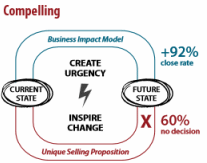Category: “Top Links”
- A CEO Checklist for High-Value Health Care
- Equipment and supplies sales to handle rising obesity rates increase
- 10 Concerns and Trends Facing Hospitals Right Now
- Urgent Care has mushroomed into an estimated $14.5 billion business
Salespeople - if you're not targeting Urgent Care you're missing one of highest growth big dollar segments of the market. Since 2008 investors have sunk $2.3 billion into urgent care clinics. The race is on to build large chains with powerful, national brands. Wall Street money is driving the growth, but so are other forces. Millions of newly insured Americans are seeking care. Others are frustrated by long waits at E.R.s, or by having to conform to regular doctor’s hours.
- 5 Common Questions Leaders Should Never Ask
“Never ask a question if you don’t want an answer.” Some good advice for leaders and salespeople from the Harvard Business Review. It used to be that providing answers was the key to success. Today asking the right questions is far more important.
- Million dollar messaging – the key to having sales conversations and business development
1. Your buyers are saying one thing and doing another
2. There is a big difference between problem finding vs. problem solving
3. Facts alone don't create insight, nor appeal to the customer
4. Salespeople must practice in order to deliver messaging well
5. Timing, appropriateness, and delivery make or break communication
6. Goal is conversations - SALES - not Best Friends Forever BFF
7. Discounting is a marketing/sales problem
8. Give aways lose sales
- Hospitals are a cost center – where healthcare is headed
- Portable DR a must to reduce turn around times
- Sell into Healthcare IT? These are the CIOs to follow on Twitter
- Molly Gamble tries to untwist the knife, “perhaps we don’t need to close hospitals.”
Last week we wrote about the CEO of Cleveland Clinic, Dr. Toby Cosgrove, championing the closure of hospitals. His cheerleader Molly Gamble is now stepping back from those comments after Alan Sager, PhD schooled her with facts. What's good for Cleveland Clinic isn't necessarily good for Healthcare. Molly, how does eating your words taste?
- What Does the Future Hold for Medtech? One word – less
Healthcare reform is creating a future that is incompatible with the business models of today. Few of today’s companies are prepared. Expect winners and notable losers among even the biggest names in the medtech industry. “An industry accustomed to growth and high margins is quickly being forced into a world of stagnation and price erosion.” Expect 20% to 25% revenue decline and a consolidation of the mega-manufactures into less than a dozen companies. Large hospital systems will control the majority of purchases and distribution will shift to low-cost delivery channels.
- Not so fast Google says, regulation so bad that Entrepreneurs won’t be innovating Healthcare
"Generally, health is just so heavily regulated. It's just a painful business to be in. It's just not necessarily how I want to spend my time. Even though we do have some health projects, and we'll be doing that to a certain extent. But I think the regulatory burden in the U.S. is so high that think it would dissuade a lot of entrepreneurs."
- HIMSS 2013 Annual Report of the U.S. Hospital IT Market – including modality penetration
If you sell in the IT space or Diagnostic Imaging Equipment this report will tell you what is being purchased, trends, and what level of penetration has occurred. For example, over 98% of academic centers have already purchased CR and DR. They are not your low hanging fruit. To find out what is read this very detailed HIMSS report.
- Hospitals plan for lasting declines in admissions
“The majority of hospitals and health systems are seeing a flattening of their inpatient volumes,” said Jeff Jones, a managing director for Huron Consulting Group. “Some are beginning to see a sustained decline." With so many major Healthcare IDN's experiencing dramatic revenue decreases costs, both operational and capital expenditures are being cut. If you aren't providing cost savings solutions to your healthcare customers you won't be in business much longer.
- Technology breakdowns a core strategic concern for hospitals
- 50 things to know about the country’s largest GPOs
- The Radiologist’s Value: Measuring the Immeasurable?
Radiologists need to be proactive in demonstrating their value in improving clinical outcomes now that CMS is adjusting payments based on quality and not volume. “In 2013, CMS started implementing the value modifier by looking at quality and cost measures and getting composite scores in each of those areas, said Judy Burleson, senior advisor on quality metrics at the American College of Radiology (ACR). Quality is on one axis, cost on the other, with low, average and high rankings for each. The score determines the potential for positive, negative or zero impact on reimbursement for Part B services. “If you’re low cost and high quality, you’d be in the upper spectrum,” she said. The physician’s performance report is compared to other physicians reporting the same measures. “
- Can you help? The top issues hospitals are considering to reduce costs
• Reducing hospital readmissions — 42.9 percent
• Maximizing efficiency with existing resources — 34.5 percent
• Implementing patient care coordination — 30.4 percent
• Changing medical malpractice laws — 30 percent
• Alternatives to physician delivery of primary care — 29.6 percent
• Improving ROI of products/technology — 23.2 percent
• Improving supply chain management — 21.3 percent
• Redesigning hospital care spaces for efficiency — 21.2 percent
- Diagnostic Imaging escapes the knife – CMS slashes at reimbursment for Radiology Oncology instead
- The top 40 thought leaders in healthcare – how many do you know?




